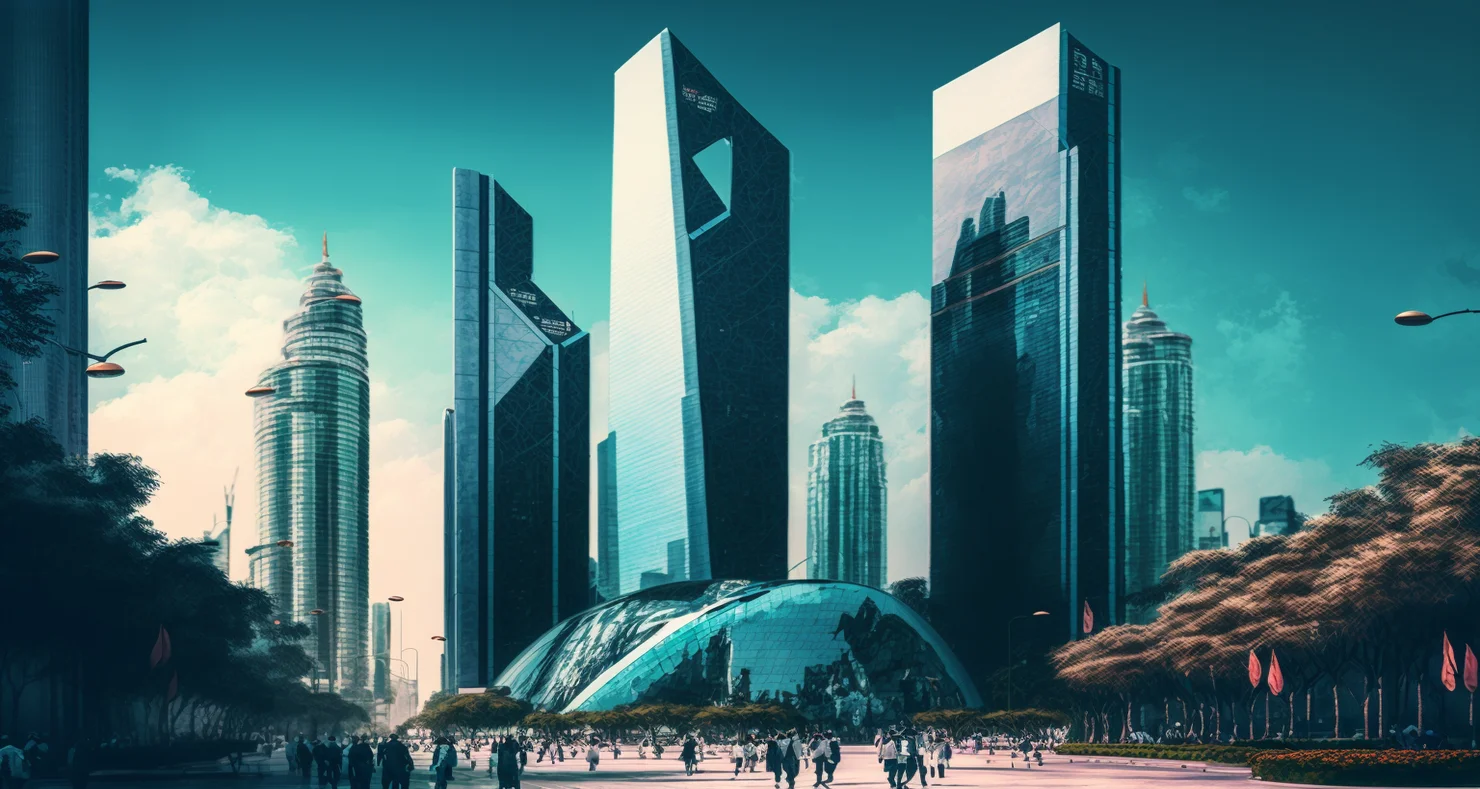Shenzhen (深 圳), a major city in China, has been recognized as a leading smart city for its innovative and advanced technologies. This article explores the Shenzhen smart city strategy, including its implementation, examples of smart city projects, and interesting facts and statistics.
Is Shenzhen 深 圳 a smart city?
Yes, Shenzhen is considered a smart city due to its focus on innovation and advanced technologies in various sectors. The city has been recognized as a leading smart city globally and has implemented several initiatives to enhance the quality of life for its residents. Here are some examples of Shenzhen’s smart city projects:
Shenzhen’s urban planning strategy involves the use of smart technologies such as 3D printing and digital mapping to optimize land use and urban design. This approach has resulted in the creation of more sustainable and efficient urban spaces.
Shenzhen (深 圳) has implemented an intelligent transportation system that includes the use of smart traffic lights, GPS technology, and real-time data analysis to optimize traffic flow and reduce congestion. This has led to a reduction in travel time and improved public transport services.
Shenzhen smart city has implemented a range of initiatives to promote energy efficiency, including the installation of smart meters, the use of renewable energy sources, and the adoption of energy-saving technologies. This has helped to reduce energy consumption and carbon emissions in the city.
Implemented a range of smart healthcare initiatives, including the use of telemedicine and mobile health technologies to improve access to healthcare services and promote preventive care. This approach has helped to reduce healthcare costs and improve health outcomes for residents.
Has developed a comprehensive smart city management system that includes the use of big data analytics, artificial intelligence, and cloud computing to monitor and manage various city services. This has led to more efficient and effective city management and improved service delivery for residents.
Some interesting facts about Shenzhen’s smart city initiatives include:
Shenzhen was named the “Smart City of the Year” at the 2019 Smart City Expo World Congress in Barcelona.
Shenzhen has been recognized as a global leader in 5G technology, with the city implementing the world’s first 5G-based unmanned driving system.
Shenzhen has invested heavily in research and development, with the city’s R&D spending exceeding 4% of its GDP, the highest among all Chinese cities.
Shenzhen’s smart city initiatives demonstrate the city’s commitment to innovation and sustainable development. The city’s use of advanced technologies in various sectors has helped to improve the quality of life for its residents and position Shenzhen (深 圳) as a global leader in smart urban development.

Shenzhen smart city project
Some interesting facts about Shenzhen’s smart city initiatives include:
Shenzhen has been recognized as a global leader in 5G technology, with the city implementing the world’s first 5G-based unmanned driving system.
Shenzhen has invested heavily in research and development, with the city’s R&D spending exceeding 4% of its GDP, the highest among all Chinese cities.
In 2018, Shenzhen launched the “Smart City Card”, a multi-functional smart card that can be used for transportation, healthcare, and other city services.
Shenzhen has been recognized as one of the most innovative cities in the world, ranking second on the 2020 Global Innovation Index.
Shenzhen’s smart city initiatives demonstrate the city’s commitment to innovation and sustainable development. The city’s use of advanced technologies in various sectors has helped to improve the quality of life for its residents and position Shenzhen as a global leader in smart urban development.

High-Tech Industries and the New Generation Information Technology
Integrated circuit: Build an industrial ecosystem with synergies to support the upgrading of the new-generation information technology industry in Shenzhen (深 圳).
Artificial intelligence: Fully leverage Shenzhen’s comparative advantages in manufacturing of terminal hardware of AI, storage of user data, innovation in application modes, thus building it as the leader in the global AI industry.
5G technology of mobile communication: Grasp the development window of 5G technology, to consolidate Shenzhen’s leading position in the global communication industry.
New type display: Consolidate its advantage as a manufacturing base for high generation large-size panel, and promote new-type display industry to become a new growth pole in electronic information industries in Shenzhen.
IoT (Internet of Things): Create a well-functioned sustainable development landscape where the upper stream and lower stream industries are closely connected.
ICV (intelligent connected vehicle): Build demonstration areas for ICV applications.
Flexible electronics: Meet the needs of wearable devices. and grasp the high ground of the next-generation electronic manufacturing industry.
In 2018, with another 3,000 newly established national high-tech companies in Shenzhen, the total number exceeds 14,000. Shenzhen is home to a cluster of enterprises spread throughout a variety of high and new technology sectors, of which the electronic information sector is one of the most prominent. This has allowed Shenzhen to become an important nationwide center for the conversion of fruitful high-tech research into successful industrial products.
Smart City Shenzen, China
2.658 Smart Points

Environment
Mobility
Connectivity
Ecology
Life quality
Citizens
Government
Average
Finance
Shenzhen is one of China’s three major financial centers. In 2018, the added value of Shenzhen’s financial industry exceeded USD 44.8 billion (RMB 300 billion), accounting for 12.7% of GDP. Shenzhen also takes the lead in fin-tech. Shenzhen is the place where the Shenzhen Stock Exchange established. The financial cluster includes the Futian District, Luohu District and Qianhai Shenzhen-Hong Kong Modern Service Industry Cooperation Zone which is going to be a demonstration area for the opening up of China’s financial industry with the comprehensive fin-tech ecosystem.
Modern Logistics
In 2018, the added value of the logistics industry in Shenzhen was USD 37.9 billion (RMB 254.158 billion), achieving a year-on-year increase of 9.35% and accounting for 10.49% of Shenzhen’s GDP. In 2018, Shenzhen became one of the first 22 cities in China to run the green freight transportation demonstration program; SF Express and the other two key logistics companies entered the Fortune China 500 list. With a throughput of 25.74 million TEUs throughout the year, Shenzhen continued to be the fourth-largest container port. Shenzhen Bao’an International Airport established routes to 15 new international passenger destination cities, achieving a total cargo and mail throughput of 1.218 million tons and ranking fourth in China.
Cultural and Creative Industries
Shenzhen was the first Chinese city to utilize a culture-based strategy for city development. In 2018, the added value of Shenzhen’s cultural and creative industry reached USD 39.1 billion (RMB 262.177 billion), accounting for more than 10% of GDP. Shenzhen was the first city nationwide to receive the title of “City of Design” from UNESCO. Design sectors such as industrial design and graphic design are in the vanguard of the nation, and Shenzhen enterprises have led China the iFDesign Awards winner for several times.
High-end Equipment Manufacturing Industry
Intelligent equipment: Consistently promote the deep integration of information technology and manufacturing industry, foster demonstration areas of intelligent manufacturing and guide the digital transformation of manufacturing companies to modern manufacturing service providers.
Additive manufacturing: Accelerate the establishment of a manufacturing innovation center for 3D printing. Form a full industrial chain covering product design, material, key components, equipment, and application to strongly underpin advanced manufacturing and precision manufacturing.
The Reform and Opening-Up policy is a significant economic reform initiative launched by China in 1978 under the leadership of Deng Xiaoping. It aimed to open up China’s economy to the world and promote economic liberalization, market-oriented reforms, and globalization.
South China, including Guangdong Province and other adjacent regions, has been one of the most dynamic and economically prosperous areas in mainland China. It has played a crucial role in the implementation and success of the Reform and Opening-Up policy.
With a population of over 100 million people, South China has been a key driver of China’s economic growth. The region has been known for its vibrant manufacturing sector, export-oriented economy, and entrepreneurial spirit. It has attracted significant foreign investment and has been a major contributor to China’s export-oriented economy.
The Reform and Opening-Up policy has led to the establishment of special economic zones (SEZs) in South China, such as Shenzhen, which have served as experimental areas for market-oriented reforms and have played a pivotal role in driving economic growth in the region. These SEZs have been centers for technological innovation, manufacturing, trade, and investment, and have attracted talent and capital from around the world.
The success of the Reform and Opening-Up policy in South China has contributed significantly to China’s economic transformation, lifting millions of people out of poverty, and propelling the country to become the world’s second-largest economy. The region has been a key engine of growth for China, driving innovation, urbanization, and economic development in mainland China.

Green and Low-carbon Industry
Energy conservation and environmental protection: Build the base and innovation center for energy-saving and environmental protection industries in l in motors, semiconductor lighting, household appliances, environmental governance, and other competitive areas.
Hydrogen fuel cell: Improve the whole industrial chain and continuously develop hydrogen economy around aerospace, aircraft, automobile and military industries. With a hydrogen-fueled electric vehicle, it will improve the whole industrial chain and constantly developing a hydrogen economy.
Biomedicine
Precision medicine: Implement the “Healthy China” strategy and conduct technological original innovation to solve the source and key issues in precision medicine and its applications. Achieve major breakthroughs in gene tests and individualized treatment technology; establish first-class precision diagnosis and treatment platform and clinical transformation system around the world.
Set up a healthcare big data platform and launch a “Big Science Initiative” for healthcare to build a leading demonstration area for precision medicine globally.
Digital Economy Industry – Financial Technology
Accelerate the establishment of financial technology research institutions to achieve breakthroughs in key technologies of digital currency wallet, verification, and management of the smart contracts, intelligent analysis of financial big data, etc. Enhance financial technology applications and proactively explore new application scenarios in order to become the leading financial technology center around the world.
New Materials Industry
Grapheme: Build a high-level innovation platform by sticking to an application-oriented approach.
Micronano material and components: Reinforce the connection of fundamental research and application study. Accelerate the industrialization to underpin further development of information, material, energy, manufacturing, and other industries.
Marine Economy Industry
Further boost overall marine economic strength and marine technological innovation capability of Shenzhen (深 圳) while sticking to the innovation-driven strategy of integrated development of land and marine economy so as to build Shenzhen (深 圳) into a global marine center city with international appeal, competitiveness, and implication.
Pearl river delta Guangdong Province, China
Guangdong Province is a coastal province located in south China, and the Pearl River Delta is a densely populated region within Guangdong Province. It is one of the most economically vibrant and developed areas in China, and it is known for its rapid industrialization, manufacturing, trade, and global economic integration.
The Pearl River Delta region includes cities such as Guangzhou, Shenzhen, Dongguan, Zhongshan, and Foshan, among others. It is a major hub for the manufacturing, particularly in electronics, textiles, and other consumer goods. It is also a key center for global trade and has established itself as an important international transportation and logistics hub.
The Pearl River Delta has experienced significant urbanization and economic growth in recent decades, with a large population and a dynamic business environment. It has become a major driver of China’s economic development and has attracted both domestic and foreign investment.
The region has also faced challenges related to environmental pollution, congestion, and urban sprawl, as rapid industrialization and urbanization have put pressure on natural resources and the environment. However, efforts have been made to address these issues and promote sustainable development in the region.
Mainland china
Mainland China refers to the part of China that is located on the Asian continent, as opposed to the special administrative regions of Hong Kong and Macau. Guangdong Province is a coastal province in southern mainland China and is one of the most populous and economically dynamic regions in the country.
Smart city development Guangdong province
Guangdong Province, located in southern China, has been at the forefront of smart city development in the country. The provincial government has been actively promoting the use of cutting-edge technologies to enhance urban management, improve public services, and foster sustainable development in its cities.
Some key initiatives and features of smart city development in Guangdong Province include:
Digital Infrastructure: Guangdong has invested significantly in building a robust digital infrastructure, including high-speed internet networks, data centers, and IoT (Internet of Things) platforms, to support various smart city applications and services.
Smart Transportation: Smart transportation systems have been deployed in many cities in Guangdong Province, including intelligent traffic management, smart parking, and public transportation management systems. These efforts aim to improve traffic efficiency, reduce congestion, and enhance overall transportation services.
E-Governance: Guangdong has implemented various e-governance initiatives to streamline administrative processes, enhance government services, and improve transparency and accountability. This includes online platforms for citizen engagement, digital public services, and government data sharing and integration.
Environmental Sustainability: Guangdong has prioritized environmental sustainability in its smart city development efforts. This includes initiatives such as smart energy management, smart waste management, and pollution monitoring and control systems to promote green and sustainable urban development.
Innovation and Entrepreneurship: Guangdong has fostered a culture of innovation and entrepreneurship, with the establishment of innovation hubs, incubators, and technology parks to attract talent and promote technological advancements in areas such as artificial intelligence (AI), big data, and 5G.
Social Services: Guangdong has also focused on leveraging smart city technologies to improve social services, including smart healthcare, smart education, and smart public safety. These efforts aim to enhance the quality of life for residents and promote social welfare.
Guangdong Province has been at the forefront of smart city development in China, with a strong emphasis on leveraging technology to enhance urban management, improve public services, and promote sustainable development.













